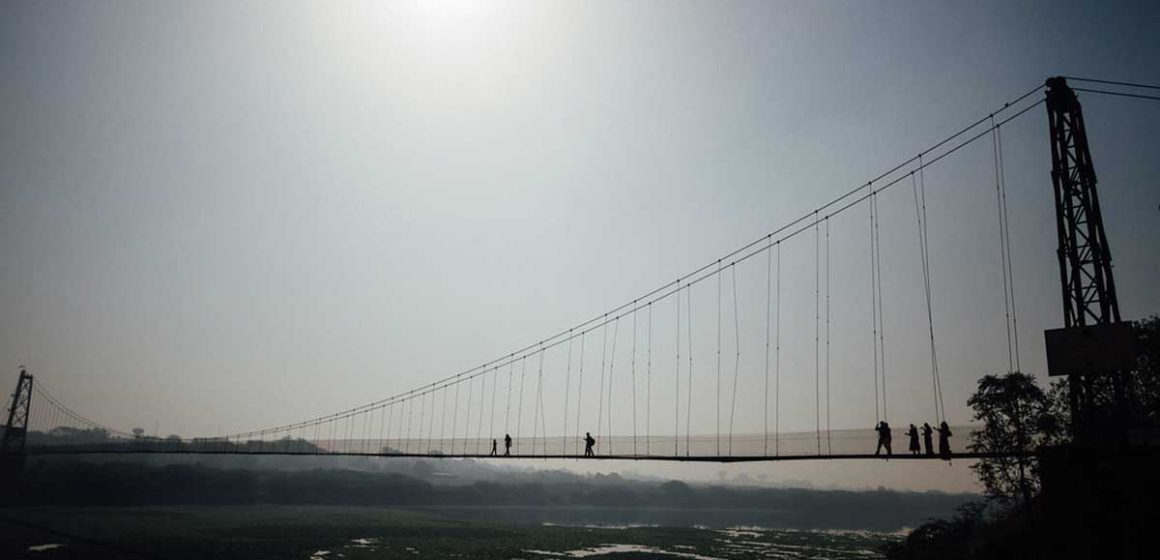The recently collapsed suspension bridge in Morbi was erected a century back, during the British era, a period that gave us numerous infrastructural edifices that still stands strong in many cases.
After enduring the load of the locals for all these years, the government officials eventually decided to refurbish this bridge and in March 2022 it was closed for renovation.
Well, let’s first understand how a typical suspension bridge structurally functions!
The deck of such types of bridges is held together using vertical suspenders or hangers made from ductile material and is subjected to tension. This deck can bear its own weight along with the weight of a certain number of people walking on it, depending on the enormity and the structural capacity of the bridge.

The suspenders of such bridge types are connected to the main cable which is again ductile and tension-specific. Structurally, the main cable spans between the points connected by the bridge, and is intermediately supported by the vertical main column piers. Ultimately, these cables provide the much-needed strength to the vertical suspenders and allow it to stand vertically strong.
The irony of the Morbi…
The bridge was opened to the public five months ahead of its scheduleThe company that renovated the bridge did not take a fitness certificate from the civic authorities before opening the bridge to the publicThe company was bound by its contract to keep the bridge shut for at least 8-12 months for maintenance and repairsBeing a Diwali Sunday, there was a rush of attractions from tourists. Even though the maximum load-carrying capacity of the bridge was around 125 people, more than thrice amount of visitors were permitted access to the bridgeJust before the mishap, some people were supposedly found jumping on the bridge and pulling its big wires. Strangely, some of the old cables of the bridge were not reinstated during the renovation
Canvassing commoner’s curiosity…
When all the national-level and monumental projects are minutely scrutinized by the authorities at every possible checkpoint, why not projects like the Morbi get the same dedicated concerns?Why human lives associated with relatively small-scale projects like Morbi are not given the same priority?Despite the structural and technical flaws, how did the company get the necessary sanctions to throw the bridge open to the public before the schedule?When every single aspect involving a suspension bridge is supposedly vulnerable, why the materials used for renovating the bridge were not thoroughly audited by the inspection authorities?Without any official fitness certification derived from the local civic authorities how the bridge got an operational go-ahead for the public?When such types of bridges require the most attention in terms of regular checks, why the timely structural audit was not adhered to while the project delivery date was still five months away?
CW’s POV…
There is a limitless disparity in the processes followed for the national-level projects vis-a-vis significantly small-scale projects in our countryThe project monitoring of these big-scale projects follows a stringent process at every stage of the project, and surprisingly the same intensity is currently missing in projects like the MorbiTechnically, all the aspects including material inspection, structural audit, project sanctions, safety certifications, and so on should have been an integral part of the stringent process that is to be followed for every single project, be it public or private, be it big or smallEven though an agreement may hold a private party responsible when dealing with citizen’s safety, the SOP must include a third party certification for ensuring safety and adherenceUnless a standardisation of process is mandated by the authorities for every single project, with the same fervour all across, we could possibly witness another Morbi
While the original structure erected a century ago stood enormously strong and suffered no mishaps, the renovated structure, barely a week old, apparently turned out to become a slayer!
This appalling episode throws some stern questions to all the stakeholders associated with this project.
It is estimated that around 50 children, along with several women and the elderly were among the dead. Ironically, the Supreme Court will take up the plea on November 14 which also happens to be Children’s Day.
Will the commoners’ lives be treated with the same sense of parity?
Will the administrators show valour in setting the right example?
Will the lessons be learned after this atrocious incident?
Perhaps the commoner will just have to wait and watch to get his answers!


